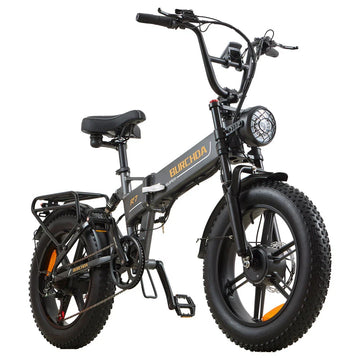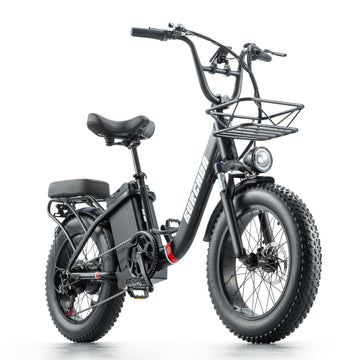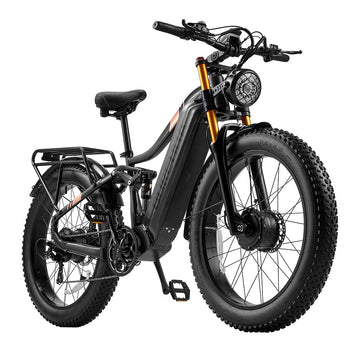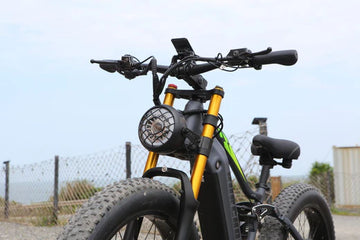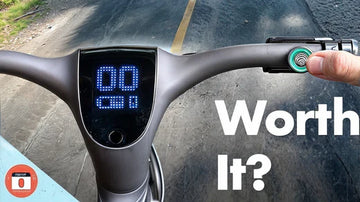Electric bikes have revolutionized the way we travel, offering a blend of efficiency, eco-friendliness, and pure, unadulterated fun. But even the most advanced e-bike can feel like a medieval torture device without the proper suspension. In this article, we'll delve into the intricacies of e-bike suspension systems, explore the different types of shocks available, and guide you on how to choose the perfect setup for your ride. Whether you're an urban commuter, a weekend warrior, or a hardcore off-road enthusiast, understanding your bike's suspension can make all the difference.

What is a Suspension System?
Before we dive into the specifics, let's establish what a suspension system is and why it's crucial for your e-bike. In simple terms, a suspension system is designed to absorb shocks from the terrain, keeping the wheels in contact with the ground and providing a smoother ride. It consists of components like springs, dampers, and linkages, which work together to mitigate the impact of uneven surfaces. The primary goal? To enhance comfort, improve control, and ensure your bike's longevity.
Types of Suspension Systems
1.Rigid Suspension:
- Description: No suspension components.
- Uses: Ideal for smooth pavement, urban commuting, and lightweight e-bikes.
-
Advantages: Simpler design, lower cost, lighter weight, less maintenance.

2.Front Suspension (Hardtail):
- Description: Suspension fork in the front only.
- Uses: Common on mountain bikes and hybrid bikes.
-
Advantages: Reduces handlebar shock, improves control and comfort on uneven surfaces, lower weight compared to full suspension.

3.Full Suspension (Dual Suspension):
- Description: Suspension on both the front fork and rear of the frame.
- Uses: Ideal for off-road, trail riding, and rough terrains.
-
Advantages: Better shock absorption, improved traction, increased comfort and control, especially on technical trails.

4.Rear Suspension Only:
- Description: Suspension only at the rear of the bike.
- Uses: Less common, can be found on some specialized bikes.
- Advantages: Provides some level of shock absorption and comfort.

Key Components of Suspension Systems
Understanding the key components of suspension systems can help you make an informed decision when choosing the right setup for your e-bike.
Springs
Springs are the backbone of your suspension system, responsible for absorbing shocks. They come in two main types:
- Coil Springs: Durable and reliable, ideal for heavy-duty use. They provide consistent performance but can be heavier.
- Air Springs: Lightweight and adjustable, perfect for fine-tuning your ride. They offer versatility but may require more maintenance.
Dampers
Dampers control the speed at which the springs compress and rebound, preventing the bike from bouncing uncontrollably. Key types include:
- Oil Dampers: Provide smooth and controlled damping but can be prone to leaks.
- Gas Dampers: Offer consistent performance and are less likely to leak, but can be more expensive.
Linkages
Linkages connect the different components of the suspension system, ensuring they work together seamlessly. The design and quality of linkages can significantly impact the performance and durability of your suspension.
How to Choose the Right Suspension System
Selecting the right suspension system for your e-bike involves considering various factors, including your riding style, the terrain you frequent, and your personal preferences.
Assess Your Riding Style
- Commuting: If you primarily ride in urban environments, a hardtail setup might be sufficient. It will handle potholes and curbs while keeping your bike light and efficient.
- Trail Riding: For those who enjoy weekend rides on light trails, a front suspension system will provide the needed comfort and control without the added weight of a full suspension.
- Off-Roading: Hardcore off-road enthusiasts will benefit from a full suspension system, which offers maximum comfort and control on rough terrain.
Consider the Terrain
- Urban: Pavement, potholes, curbs.
- Light Trails: Dirt paths, small rocks, roots.
- Rugged Trails: Rocks, roots, steep descents.
Budget and Maintenance
- Budget: Determine your budget and weigh the cost against the benefits. Remember, a more expensive system might save you money in the long run by reducing wear and tear on your bike and body.
-
Maintenance: Consider how much time and effort you're willing to invest in maintenance. Full suspension systems offer better performance but require more upkeep.

In the world of e-bikes, the right suspension system can make all the difference. It’s not just about smooth rides; it’s about transforming your journey into an experience you look forward to every day. So, gear up, choose wisely, and get ready to conquer the roads and trails with confidence and comfort. Happy riding!

